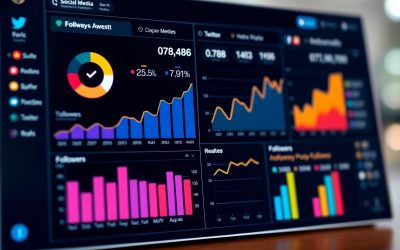There’s a game-changing strategy that can elevate your brand’s online presence, and that’s social media scheduling. If you’re tired of scrambling for posts at the last minute and ready to unleash high-impact campaigns that resonate with your audience, you’ve landed in the right place! This guide is all about giving you the tools and insights needed to plan your content effectively, boost engagement, and drive real results. Get ready to transform your approach and make scheduling an integral part of your marketing playbook!
Key Takeaways:
- Establish a content calendar to streamline your posting schedule and ensure consistent engagement across all social media platforms.
- Utilize analytical tools to track the performance of your campaigns, allowing for real-time adjustments and improved decision-making.
- Incorporate a variety of content types, such as videos, images, and polls, to maintain audience interest and enhance reach.
Crafting Your Social Media Strategy
Defining Your Audience and Goals
You can’t hit a target if you don’t know what it is. Start by diving deep into understanding who your audience is. Utilize data analytics tools to segment your demographics—age, interests, buying behaviors—and create buyer personas that are reflective of your actual customer base. People are not just numbers. They’re human beings with unique stories, and by designing your messaging around their pains and pleasures, you ensure it resonates on a personal level. Clear goals should be set alongside your audience profiles; are they meant to increase brand awareness, drive traffic, or enhance community engagement? Outline SMART objectives—Specific, Measurable, Achievable, Relevant, Time-bound—that align with both your audience and your overall business mission.
Selecting the Right Platforms for Engagement
After you’ve nailed down your audience and objectives, choose the platforms that best suit your strategy. Each social media channel has its nuances and caters to different demographic segments. For instance, if your target audience skews younger, platforms like TikTok or Instagram should be at the forefront of your efforts. Alternatively, LinkedIn is a powerhouse for B2B engagement, perfect for building professional relationships and showcasing expertise. Analyze user behavior metrics to determine where your ideal customers hang out most. You might find that while Facebook provides reach, Twitter can foster conversations, and Snapchat may cater to trendy, bite-sized content that reflects your brand’s image.
The landscape of social media is constantly evolving, and emerging platforms can offer untapped opportunities. For example, platforms like Threads provide a fresh avenue to engage with audiences in a way that feels direct and personal. Always be ready to adapt and test the waters, because what works today may not work tomorrow. Harness these channels not just for posting, but to initiate conversations, gather feedback, and build lasting relationships that keep your community not just engaged, but truly invested.
The Art of Content Creation
Developing a Content Calendar that Works
Building a content calendar isn’t just a scheduling exercise; it’s a roadmap for your audience engagement. Visualize your content across different platforms and dates, making sure you mix up post types, whether that’s promotional content, engaging questions, or behind-the-scenes looks into your business. Tools like Trello or Asana can streamline your visual plan, allowing you to add deadlines and reminders that keep your whole team aligned. You’ll want to focus on consistency in timing and messaging, as well as align your campaigns with relevant events or trends; for instance, holidays, product launches, or even trending hashtags can spice up your calendar and keep your audience buzzing.
Start by identifying key themes or topics that resonate with your audience. If you’re in the fitness industry, think ‘New Year resolutions’ for January and ‘Summer Body Prep’ for the months leading into warmer weather. By filling out your calendar ahead of time—and allowing flexibility for real-time updates—you’ll find it easier to be authentic and personable. This approach can lead to enhanced engagement rates, helping you stay top-of-mind for your audience.
Balancing Original Content and Curated Posts
The beauty of social media lies in its diversity, and your content strategy should reflect that. Mixing original content with curated posts not only keeps your feed fresh but also establishes your authority as a thought leader in your niche. Original content, like blog posts or videos, showcases your unique brand voice, while curated content—links to articles, infographics, or user-generated posts—can offer valuable insights without the extra effort of creation. Aim for a ratio that feels organic for your audience; for many brands, 70% original and 30% curated works well.
Balancing original and curated posts isn’t just about the numbers; it’s about maintaining your brand’s voice while also providing your audience with value. Curating content helps you stay in the conversation, ensuring that you’re sharing relevant industry insights or trending topics that your audience cares about. Plus, this strategy can strengthen relationships with other creators and brands, leading to potential collaborations down the line. Think of it as being the go-to resource in your space—offering not just your perspective but also amplifying voices that align with your vision.
Timing is Everything: The Science of Posting
Analyzing Peak Engagement Times
Understanding peak engagement times can be a game changer in your social media strategy. Every audience has unique habits, influenced by factors like location, age, and interests. Dive deep into your follower demographics and behaviors to highlight the most active times when your posts are likely to resonate the most. For example, studies show that posts shared during lunch hours (11 AM – 1 PM) usually garner higher interaction rates. Weekdays typically see more engagement than weekends, especially for B2B brands, while lifestyle brands might shine brighter on weekends. Utilize these insights to ensure your content hits your audience when they’re most receptive.
Your analytics can provide a treasure trove of data that you can leverage to find the best times to post. By using insights from platforms like Facebook, Instagram, and Twitter, you can track historical engagement rates by day and time and tailor your posting schedule accordingly. A/B testing different times for similar content can refine your understanding and create a more responsive engagement pattern with your audience.
Leveraging Analytics for Optimal Scheduling
Utilizing analytics tools effectively can lead to significant improvements in your social media scheduling efforts. By analyzing your past posts and their performance, you can determine which times and days yield the highest engagement rates. Tools like Sprout Social or Hootsuite provide detailed reports on user interactions that go beyond likes and shares, venturing into comments and click-through rates. Studying this data closely allows you to pinpoint patterns and gives you clarity on the optimal posting schedule that suits your audience.
It’s all about the numbers. Whether it’s the rise in engagement during the evening hours for your audience or a noticeable dip during midday, leveraging analytics allows you to craft a posting strategy that aligns perfectly with their active hours. Take the time to continuously monitor your analytics, adjusting your strategy and timing as your audience evolves. Regularly updating your schedule based on fresh insights keeps your campaigns dynamic and impactful.
In practical terms, aim for a schedule that optimizes post frequency around peak audience engagement. If your analytics indicate that your followers are particularly active on Thursdays at 7 PM, you might want to post your most high-impact content during that time. The ability to pivot and adjust based on real-time analytics can set you apart from those relying on generic posting schedules. Consistently monitoring your engagement data gives you the agility you need to stay ahead of the game and ensure your campaigns consistently hit their mark.
Tools of the Trade: Best Scheduling Software
Key Features to Look For
Choosing the right scheduling software can make all the difference in how effectively you execute your social media campaigns. Look for platforms with attributes that align with your operational needs and engagement goals. The ability to manage multiple social media profiles in one place is a non-negotiable for efficiency. Additionally, ease of use should be a priority; a clean user interface allows you to spend more time on content creation rather than getting lost in complex navigation. Lastly, robust analytics tools are vital for understanding your audience’s reactions and optimizing your future strategies based on what’s working.
- Multi-Platform Management: Coordinate campaigns across various social networks.
- Content Calendar: Visualize your posting schedule with easy drag-and-drop features.
- Automated Posting: Schedule content for posting in advance to maintain consistent output.
- Analytics and Reporting: Insights on engagement metrics and audience behavior.
- Collaboration Tools: Enable team members to contribute and manage content seamlessly.
- URL Shortening: Incorporate easy link management for trackable engagement.
Any time you invest in finding the right tools pays off in the long run. Choose wisely, and it becomes easier to scale your campaigns effectively.
Comparing Popular Social Media Scheduling Tools
As far as selecting scheduling tools, familiarizing yourself with popular options helps narrow down your choices based on features and affordability. Tools like Hootsuite, Buffer, Sprout Social, and Later each come with their own benefits and limitations. Hootsuite is widely acclaimed for its multi-platform management capabilities, while Buffer excels in user-friendliness. Sprout Social is lauded for its analytics, which aids in delivering deep insights, and Later excels in visual content planning. The nuances in functionality make direct comparisons vital for your decision-making process.
| Tool | Key Features |
|---|---|
| Hootsuite | Multi-platform management, powerful analytics, team collaboration. |
| Buffer | Simple scheduling, posting queue, user-friendly interface. |
| Sprout Social | In-depth reports, social listening, engagement features. |
| Later | Visual content planning, media library, Instagram-focused features. |
Understanding the strengths and weaknesses of each tool sets you up for success in selecting one that meets your unique needs. Evaluate your primary requirements, be it analytics, ease of use, or additional features, to enhance your social media scheduling strategy effectively.
Maintaining Consistency and Quality
Establishing Brand Voice Across Platforms
Your brand voice is the personality that resonates with your audience and should be unmistakably consistent across every platform. It’s like showing up to a party and knowing that your best friend is the one wearing the signature jacket. If you’re funny on Twitter, heartfelt on Instagram, and professional on LinkedIn, things could get confusing for your audience. Aim for a cohesive tone that reflects your brand’s identity, whether you’re launching a campaign on TikTok or sharing insights on Facebook. This means crafting a set of guidelines or a style guide that defines your tone, vocabulary, and even emojis to use—so when your audience sees “your voice,” it’s instantly recognizable.
In practice, you might leverage social media management tools that let you preview posts across platforms before they go live. This foresight can help tailor your messaging without losing your essence. A great example is how Nike maintains its empowering, motivational, and active voice whether you’re reading a tweet or viewing a video. They’ve done the work to ensure that their audience feels the same energy and authenticity regardless of where they engage with the brand.
Implementing Quality Control Measures
Quality control acts as a safety net that ensures your posts are polished and aligned with your brand’s ethos. Implement established review processes for your content before it goes live, whether that means having a team member check for spelling mistakes, verifying facts, or ensuring that the visuals are on-point. Automating scheduling doesn’t mean you should ditch the human touch. A structured check-in or approval system creates an added layer of accountability that can save you from potential backlash—a typo or misaligned image can damage your brand reputation fast.
Utilizing metrics to gauge what content resonates can be a game-changer as well. After running a campaign, analyze the data for likes, shares, and comments to determine which messages hit home—and which didn’t. Conduct regular audits on your social media pages to take stock of your performance and see where adjustments are needed. Brands like Starbucks utilize customer feedback loops to refine their offerings and engage with their audience directly, ensuring their content stays relevant and high quality.
By incorporating rigorous quality checks, not only do you enhance your brand’s credibility, but you also foster trust with your audience. When your followers know they can count on you for reliable and engaging content, they’re more likely to become loyal advocates for your brand.

Measuring Success: Metrics that Matter
Tracking Engagement and Interaction Rates
You can’t manage what you don’t measure, and in the world of social media, engagement rates are your first line of defense against mediocrity. Start by analyzing likes, comments, shares, and clicks on your posts. These metrics paint a clear picture of how your audience is interacting with your content. For instance, a post that garners high shares suggests that your message resonated, igniting further conversation among users. The secret is finding the right metrics for your goals—consider the difference between a post aimed at generating brand awareness and one focused on driving sales.
Diving deeper into specifics, look at the engagement rate, which is calculated by dividing the total engagement (likes, comments, shares) by your follower count, then multiplying by 100. A benchmark engagement rate on platforms like Instagram tends to hover around 1-3%. If your posts are consistently outperforming these numbers, you’re on the right track! Keep track of this data over time—watch for trends and note what types of content elicit the highest response. This insight is invaluable for sharpening your content creation strategy.
Adapting Campaigns Based on Performance Insights
Your initial strategy won’t be perfect, and that’s where the power of adaptation comes into play. Use the metrics you gathered to tweak your campaigns in real-time. If a particular post type—say, videos—has significantly higher interaction rates than static images, prioritize video content moving forward. This process isn’t about folding under pressure; it’s about embracing a dynamic approach that leverages audience feedback with every piece of content you produce.
Further analysis can reveal patterns in your audience’s behavior. A spike in engagement around specific topics or times of the day should be treated as gospel. If your posts about sustainability attract attention on Wednesdays at noon, capitalize on this by scheduling similar content during that slot. It’s all about being fluid and responsive in your strategy, allowing you to amplify the content that truly resonates with your audience.
When adapting campaigns based on performance insights, digging into the data becomes your best friend. Take a look at A/B testing results to determine which headlines, images, or messaging variations yield the best clicks or shares. If audience demographics show a shift, don’t hesitate to pivot your content to match their evolving interests or behaviors. By staying vigilant and flexible, you can align your strategies with fresh insights to maximize impact, ensuring that each campaign builds on the successes and lessons of the last.
To wrap up
Considering all points, it’s clear that social media scheduling isn’t just another task on your to-do list – it’s an vital strategy that can take your campaigns from basic to brilliant. You’ve got the tools at your fingertips, so don’t waste a second. Dive into the metrics, analyze your audience, and create a content calendar that reflects your brand’s vibe and goals. Consistency is your friend, but don’t mistake routine for redundancy; keep that content fresh and engaging, and you’ll see the impact ripple through your entire strategy.
Ultimately, your success hinges on how well you can connect with your audience and provide value. Scheduling isn’t limiting; it’s liberating. It gives you the chance to focus on what truly matters: crafting amazing content and building those authentic relationships that drive results. So get out there, let your creativity shine, and own those social media channels like the rock star you are. The world’s waiting to hear what you’ve got to say!





0 Comments